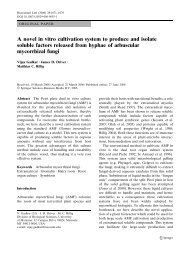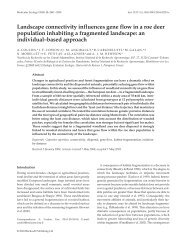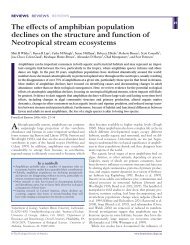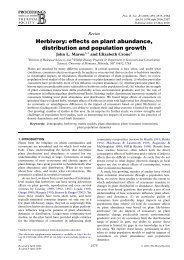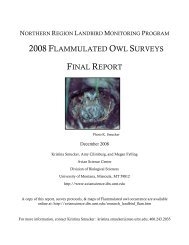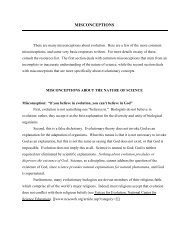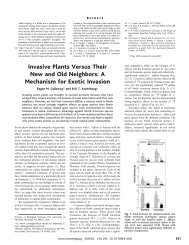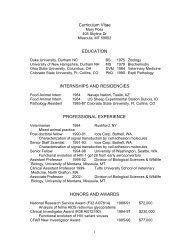Evolution of Antibiotic Resistance-Printable Format - Teach ...
Evolution of Antibiotic Resistance-Printable Format - Teach ...
Evolution of Antibiotic Resistance-Printable Format - Teach ...
Create successful ePaper yourself
Turn your PDF publications into a flip-book with our unique Google optimized e-Paper software.
a tolerance to the drug? Have they physiologically acclimated to the presence <strong>of</strong> the<br />
antibiotic so that it no longer affects them? No. What has happened is bacterial evolution.<br />
Mutations that allow the bacteria to resist the effects <strong>of</strong> the antibiotic occur and have a<br />
selective advantage. These mutations have the type <strong>of</strong> effects that were described in the<br />
previous paragraph (for example, there is a mutation that results in an altered form <strong>of</strong> the<br />
target site). These resistance characters are <strong>of</strong>ten simple mutations (i.e. changes in a single<br />
gene). The result is that resistant bacteria differ genetically from their susceptible<br />
ancestors.<br />
So what happens if a bacterial cell has a mutation that allows it to resist the effect <strong>of</strong> an<br />
antibiotic? If that bacterium is in the presence <strong>of</strong> the antibiotic, then it will have an<br />
advantage: the drug will not kill it! It will be able to reproduce, while the susceptible<br />
bacteria (which are inhibited or killed by the antibiotic) will not. In the presence <strong>of</strong> the<br />
antibiotic, the resistant mutant has a selective (reproductive) advantage over normal cells 3 .<br />
Originally, most or all bacteria in the population were susceptible to the antibiotic 4 . Over<br />
many generations, the resistant type will make up a greater and greater percentage <strong>of</strong> the<br />
population. Eventually, most or all <strong>of</strong> the individuals in the bacterial population will be<br />
resistant to the antibiotic. The population has evolved resistance due to natural selection by<br />
antibiotics: the genetic structure <strong>of</strong> the population has changed, from susceptible to the<br />
antibiotic to resistant to the antibiotic.<br />
Why Does <strong>Resistance</strong> Evolve so Quickly?<br />
Bacterial populations can evolve resistance very quickly. For example, in one<br />
hospital, initially 5% <strong>of</strong> the strains <strong>of</strong> staphylococcal bacteria were resistant to the antibiotic<br />
cipr<strong>of</strong>loxacin. Within one year, 80% <strong>of</strong> the bacterial strains were resistant. From 5% to 80%<br />
in one year! Why do bacterial populations evolve resistance so quickly? There are two basic<br />
reasons:<br />
1) in general, bacteria have the capacity to evolve quickly<br />
2) humans are helping them to evolve even faster<br />
Bacteria Biology<br />
There are several aspects <strong>of</strong> bacteria biology that contribute to their capacity for rapid<br />
evolution. Bacteria, relative to humans, have very short generation times. A generation<br />
3 Note: when these mutations occur in the absence <strong>of</strong> the antibiotic, the resistant form does not have a selective<br />
advantage, and evolution <strong>of</strong> resistance does not occur. Typically, these resistance characters are evolutionarily<br />
costly to the bacteria that have them (e.g. they must divert energy from reproduction to maintaining the<br />
resistance character), so when these mutations occur in the absence <strong>of</strong> the antibiotic, they are selected against.<br />
4 There may also be a very small percentage <strong>of</strong> the original population that is naturally resistant to the antibiotic.<br />
Naturally resistant bacteria are partially resistant—they are not be killed by a low dosage <strong>of</strong> the antibiotic, but<br />
will be killed by a higher dosage. This is analogous to humans and the flu—not everyone gets the flu, even if<br />
they are exposed to it (some people are naturally resistant). Naturally resistant bacteria were present long<br />
before the first antibiotics were used in humans (a legacy <strong>of</strong> the age-old arms race between competing<br />
microorganisms). Since the heavy use <strong>of</strong> antibiotics in humans, they have become much more common, and<br />
mutations that strengthen this partial resistance have been selected for.



